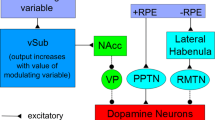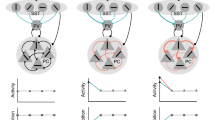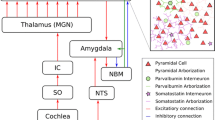Abstract
Hypothetical mechanisms of the neocorticohippocampal system are presented. Neurophysiological and neuroanatomical findings concerning the system are integrated to demonstrate how animals associate sensory stimuli with rewarding actions: (1) cortical plasticity regulated by cholinergic/noradrenergic inputs from the hypothalamic reward system reinforces association connections between the most activated columns in the cortex; (2) the repetitive reinforcement forms association pathways connecting sensory cortical columns activated by the stimuli with motor cortical columns producing the rewarding actions; (3) after the pathways are formed, the cortex is capable of temporarily memorizing the stimuli by producing long-term potentiation through the cortico-hippocampal circuits; and (4) the memory allows the cortex to extend correct association pathways even in an environment where sensory stimuli rapidly change. A mathematical model of parts of the nervous system is presented to quantitatively examine the mechanisms. Membrane characteristics of single neurons are given by the Hodgkin-Huxley electric circuit. According to anatomical data, neural circuits of the neocortico-hippocampal system are composed by connecting populations of the model neurons. Computer simulation using physiological data concerning ion channels demonstrates how the mechanisms work and how to test the hypotheses presented.
Similar content being viewed by others
References
Ahlsén G, Lindström S (1982a) Excitation of perigeniculate neurones via axon collaterals of principal cells. Brain Res 236:477–481
Ahlsén G, Lindström S (1982b) Mutual inhibition between perigeniculate neurons. Brain Res 236:482–486
Ahlsén G, Lindström S (1983) Corticofugal projection to perigeniculate neurons in the cat. Acta Physiol Scand 118:181–184
Amari S (1972) Characteristics of random net of analog neuron-like elements. IEEE Trans Syst Man Cybern 2:643–657
Asanuma H, Sakata H (1967) Functional organization of a cortical efferent system examined with focal depth simulation in cats. J Neurophysiol 30:35–54
Bliss TVP, Lømo T (1973) Long-lasting potentiation of synaptic transmission in the dentate area of the anaesthetized rabbit following stimulation of the perfrant path. J Physiol (Lond) 232:331–356
Crick F, Asanuma C (1986) Certain aspects of the anatomy and physiology of the cerebral cortex. In: McClelland JL, Rumelhart DE (eds) Parallel distributed processing, vol 2. MIT Press, Cambridge, pp 333–371
Eccles JC (1964) The physiology of synapses. Springer, New York Berlin Heidelberg
Gordon B, Allen EE, Trombley PQ (1988) The role of nore pinephrine in plasticity of visual cortex. Prog Neurobiol 30:171–191
Iriki A, Pavlides C, Keller A, Asanuma H (1991) Long-term potentiation of thalamic input to the motor cortex induced by coactivation of thalamocortical and corticocortical afferents. J Neurophysiol 65:1435–1441
Ishizuka N (1989) Structural organization of hippocampal cortex. Brain Nerve 41:753–770
Jahnsen H, Llinás R (1984a) Electrophysiological properties of guinea-pig thalamic neurones: an in vitro study. J Physiol (Lond) 349:205–226
Jahnsen H, Llinás R (1984b) Ionic basis for the electroresponsiveness and oscillatory properties of guinea-pig thalamic neurones in vitro. J Physiol (Lond) 349:227–247
Jones EG (1975) Some aspects of the organization of the thalamic reticular complex. J Comp Neurol 162:285–308
Kalil RE, Dubin MW, Scott G, Stark LA (1986) Elimination of action potentials blocks the structural development of retinogeniculate synapses. Nature 323:156–158
Kandel ER, Klein M, Hochner B, Shuster M, Siegelbaum SA, Hawkins RD, Glanzman DL, Castellucci VF, Abrams TW (1987) In: Edelman GM, Gall WE, Cowan WM (eds) Synaptic function. Wiley, New York, pp 471–518
Kuba K, Kumamoto E (1990) Long-term potentiations in vertebrate synapses: a variety of cascades witch ommon subprocesses. Prog Neurobiol 34: 197–269
Luria AR (1973) The working brain. Penguin, London
Lynch G, Larson J, Kelso S, Barrionuevo G, Schottler F (1983) Intracellular injections of EGTA block induction of hippocampal long-term potentiation. Nature 305:719–721
Mishkin M (1982) A memory system in the monkey. Phil Trans R Soc Lond B 298:85–95
Miyashita Y (1985) Is the hippocampus a memory system? Reappraisal Seitai No Kagaku 36:636–640
Montero VM, Guillery RW, Woolsey CN (1977) Retinotopic organization within the thalamic reticular nucleus demonstrated by a double label autoradiographic technique. Brain Res 138:407–421
Nakamura K, Ichikawa A (1990) Cerebral mechanism for rewardmediated learning: a mathematical model of neuropopulational network plasticity. Biol Cybern 63:1–13
Ohara PT, Sefton AJ, Lieberman AR (1980) Mode of termination of afferents from the thalamic reticular nucleus in the dorsal lateral geniculate nucleus of the rat. Brain Res 197:503–506
Olds J (1977) Drives and reinforcements: behavioral studies of hypothalamic functions. Raven Press, New York
Olton DS, Becker JT, Handelmann GE (1979) Hippocampus, space, and memory. Behav Brain Sci 2:313–365
Scheibel ME, Scheibel AB (1966) The organization of the nucleus reticularis thalami: a golgi study. Brain Res 1:43–62
Sherman SM, Koch C (1986) The control of retinogeniculate transmission in the mammalian lateral geniculate nucleus. Exp Brain Res 63:1–20
Teyler TJ, DiScenna P (1986) The hippocampal memory indexing theory. Behav Neurosci 100:147–154
Van Hoesen GW (1982) The parahippocampal gyrus: new observations regarding its cortical connections in the monkey. Trends Neurosci Oct:345–350
Wilson HR, Cowan JD (1972) Excitatory and inhibitory interactions in localized populations of model neurons. Biophys J 12:1–24
Yukie M, Takeuchi H, Hasegawa Y, Iwai E (1990) Differential connectivity of inferotemporal area TE with the amygdala and the hippocampus in the monkey. In: Iwai E, Mishkin M (eds) Vision, memory, and the temporal lobe. Elsevier, New York, pp 129–135
Zola-Morgan S, Squire LR, Amaral DG, Suzuki WA (1989) Lesions of perirhinal and parahippocampal cortex that spare the amyg dala and hippocampal formation produce severe memory impairment. J Neurosci 9:4355–4370
Author information
Authors and Affiliations
Rights and permissions
About this article
Cite this article
Nakamura, K. A theory of cerebral learning regulated by the reward system. Biol. Cybern. 68, 491–498 (1993). https://doi.org/10.1007/BF00200808
Received:
Accepted:
Issue Date:
DOI: https://doi.org/10.1007/BF00200808




